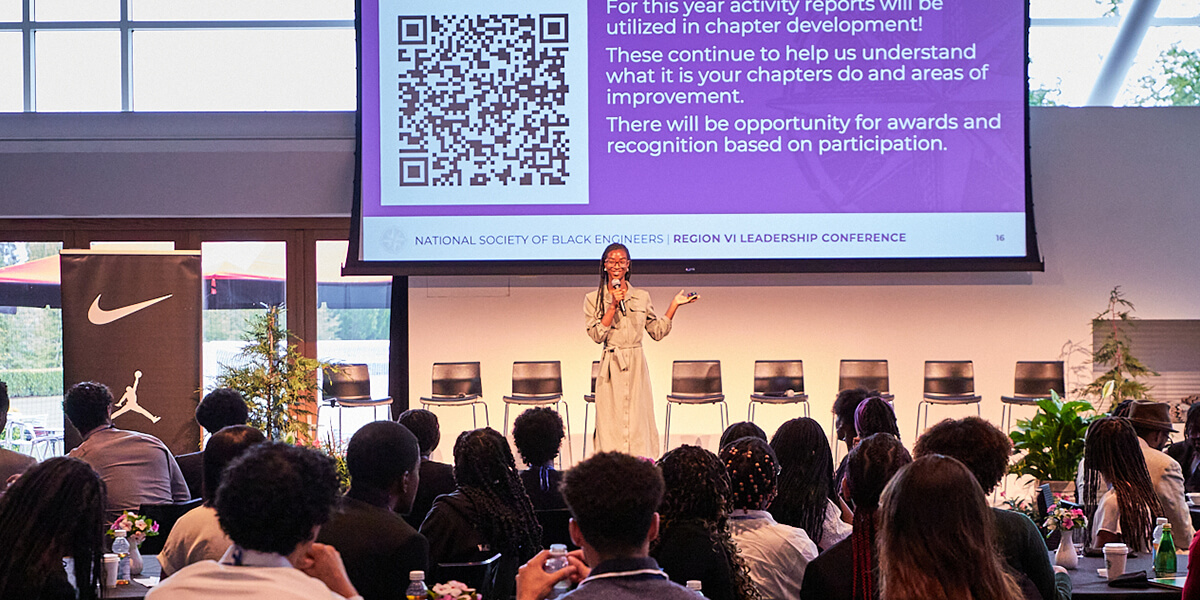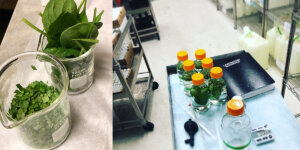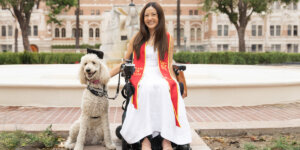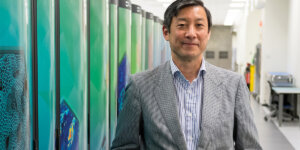
Victoria Pinkett presents as vice chair of the National Society of Black Engineers (NSBE)
Graduating mechanical engineer Victoria Pinkett has a practical frame of mind. While some engineers are drawn to the math and fundamental theories, Pinkett has always had a tendency to take a hands-on approach. From designing the most aerodynamic wings for optimal flight, to taking on student leadership roles, to winning a coveted internship at SpaceX – it’s fair to say she’s ready for some real-world problem solving.
You interned at SpaceX last summer. What were some of the highlights and key takeaways?
I secured the internship after connecting with a SpaceX recruiter through an event at USC! This gave me the chance to work on their Starlink program as a hardware reliability engineering intern. Starlink involves creating satellites for space-based internet and user terminals that function as Wi-Fi antennas, power supplies and routers.
One of the most rewarding aspects about working on Starlink was the opportunity to help provide internet access worldwide, especially in areas where it had been previously inaccessible. It was fulfilling to be part of a project that connects people worldwide and gives them access to new resources.
During my internship, I gained valuable engineering experience by taking ownership of projects and diving into concepts I had only briefly explored in school. I was mainly working on root cause analysis, hardware testing, design of experiments and studying large-scale, rapid manufacturing processes.
It seems like you’ve had some amazing opportunities through USC. Reflecting on your time here, what academic project stands out as most significant?
My senior design project was an amazing learning experience. In their senior year, mechanical engineering students work in small groups to conceive, design, build and test a project from scratch. My group did a comparative analysis of the impact of wing flexibility on thrust. We constructed paper airplane wings with wires to make them more rigid or more flexible, then we tested how fast each wing design could generate thrust when set in motion.
We were able to apply concepts we’d been learning in our classes, such as design, 3D printing, motors and testing with LabVIEW. It was an incredibly rewarding process that allowed us to collaborate, problem-solve and bring an engineering project to life.
What is the significance of analyzing wing flexibility?
Understanding wing flexibility helps to make aircraft wings more efficient; though careful analysis, we can optimize wing designs to provide enhanced thrust and efficiency with lightweight construction. Our project contributed to current industry research for advancing commercial aircraft and drones.
What were some of the other valuable, hands-on learning experiences you had access to at USC Viterbi?
My involvement with Viterbi Makers was incredibly valuable. It’s an incredible design team that completes year-long electronics and robotics projects. During my sophomore year, our team built a robotic drumming system called “Robot Rock.” I played a key role in designing the robot, ensuring all the components were properly aligned so it could produce sound and function cohesively.
As a relatively new student, I had minimal experience with hands-on engineering projects. Working on “Robot Rock” pushed me out of my comfort zone and allowed me to apply concepts I’d been learning in class to a tangible project.
Collaborating with students across different years and majors taught me invaluable lessons on effective teamwork. This project allowed me to develop my communication and collaboration skills which really helped me during my time at USC.
In what ways have you contributed your leadership skills to the USC Viterbi community?
I’ve been involved with the Viterbi Student Ambassador program since my freshman year. It’s been one of my favorite and most fulfilling involvements. Acting as a liaison between the Viterbi Admissions Office and prospective high school students, I shared insights on why I chose USC, student life, my specific major, and the general engineering experience. I assisted with admitted students’ day events and created content such as podcasts and Instagram posts.
I vividly remember being a high school senior trying to decide where to attend college. Listening to the Viterbi ambassadors share their passion for USC, their diverse activities and how much they had grown here really encouraged me to come here. Their enthusiasm made me incredibly excited to become a Viterbi engineering student myself. I’ve been honored to pay that forward and help future engineers envision their potential here.
You have also held leadership roles at the National Society of Black Engineers (NSBE). What was your experience in these roles, especially as national vice chair?
Throughout my time at USC, I became really involved in NSBE, a national student-run organization with collegiate chapters, including one at USC.
I started as the western regional TORCH (Technical Outreach and Community Help) chair, organizing events to expose people to engineering. During my junior year, I served as the Western Region chair, facilitating chapter connections and organizing a regional conference with a career fair and professional development workshops. This year, I was the national vice chair, overseeing membership engagement initiatives, chapter programming and planning the national convention in Atlanta for 18,000 attendees.
Serving as a NSBE leader taught me strategic planning, communication and what it means to be a servant leader invested in others’ growth. My experience with NSBE has undoubtedly made me a better person and engineer.
What are your plans after graduating from USC?
I’ll be moving to the East Coast to work for Pratt & Whitney, a leading company in jet engine design and manufacturing. I’ll be part of their rotational engineering development program. Long-term, I’m fascinated by the idea of working on human spaceflight initiatives – potentially even contributing to efforts to return to the Moon and eventually for human exploration of Mars. In the coming years, the pursuit to push the boundaries of space exploration will be an incredible way to way to use my engineering skills!
Published on May 8th, 2024
Last updated on May 8th, 2024












